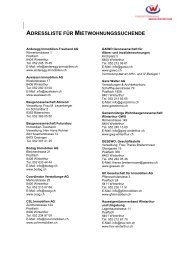Handbook for Investors. Business location in Switzerland.
Handbook for Investors. Business location in Switzerland.
Handbook for Investors. Business location in Switzerland.
Create successful ePaper yourself
Turn your PDF publications into a flip-book with our unique Google optimized e-Paper software.
<strong>for</strong> a specific period from unemployment <strong>in</strong>surance by apply<strong>in</strong>g<br />
<strong>for</strong> short-time work<strong>in</strong>g. This is done to prevent dismissal as a<br />
result of a temporary and unavoidable lack of work.<br />
Dismissals are the last means that a company can resort to when<br />
utilization levels fluctuate. In the event of mass redundancies,<br />
Sections 335d – 335g of the Swiss Code of Obligations stipulate<br />
that the employer<br />
• must consult the employees, and<br />
• must <strong>in</strong><strong>for</strong>m the cantonal labor office <strong>in</strong> writ<strong>in</strong>g.<br />
Compared with other countries, <strong>Switzerland</strong> has highly <strong>in</strong>vestorfriendly<br />
labor market provisions. It is relatively easy <strong>for</strong> companies<br />
to appo<strong>in</strong>t and dismiss employees.<br />
Fig. 40: Appo<strong>in</strong>tments and dismissals (2008)<br />
1 = hampered by regulation, 7 = employers have flexibility<br />
<strong>in</strong> decision-mak<strong>in</strong>g<br />
1 S<strong>in</strong>gapore 5.9<br />
2 Denmark 5.9<br />
3 Hong Kong SAR 5.8<br />
4 <strong>Switzerland</strong> 5.6<br />
5 Bosnia and Herzegov<strong>in</strong>a 5.5<br />
8 USA 5.4<br />
43 Russia 4.2<br />
50 UK 4.1<br />
74 Ireland 3.8<br />
77 Ch<strong>in</strong>a 3.8<br />
103 India 3.2<br />
111 Luxembourg 3.1<br />
114 Netherlands 3.0<br />
115 Belgium 3.0<br />
116 Japan 3.0<br />
118 Brazil 2.9<br />
119 France 2.8<br />
126 Germany 2.5<br />
128 Italy 2.5<br />
8.6 Social <strong>in</strong>surance.<br />
The Swiss social <strong>in</strong>surance system is based on three coord<strong>in</strong>ated<br />
pillars: state-sponsored, employer-sponsored and personal plans.<br />
Personal responsibility is a key factor <strong>in</strong> this system. As a result,<br />
the overall tax and contribution burden rema<strong>in</strong>s modest by <strong>in</strong>ternational<br />
standards.<br />
The three pillars of Swiss social security:<br />
Pillar 1: This first level meets the basic needs of the <strong>in</strong>sured or<br />
beneficiary through the government-sponsored old age and<br />
survivors’ pension (OASI), as well as long-term disability <strong>in</strong>surance<br />
or <strong>in</strong>capacity benefit (DI). Both are compulsory and are<br />
funded jo<strong>in</strong>tly through contributions (percentage of salary) by the<br />
employer and the employee.<br />
Pillar 2: The occupational pension plan (BVG), which supplements<br />
the first pillar, makes it possible <strong>for</strong> retired persons to ma<strong>in</strong>ta<strong>in</strong><br />
their accustomed standard of liv<strong>in</strong>g after retirement. All persons<br />
work<strong>in</strong>g <strong>in</strong> <strong>Switzerland</strong> must be <strong>in</strong>sured. The plans are funded<br />
through contributions (percentage of salary) by the employer and<br />
the employee.<br />
Pillar 3: Personal voluntary retirement plans of employees or<br />
self-employed <strong>in</strong>dividuals cover additional personal needs, ma<strong>in</strong>ly<br />
through bank and <strong>in</strong>surance sav<strong>in</strong>gs. Contributions to <strong>in</strong>dividual<br />
retirement plans enjoy preferential treatment under tax laws to<br />
some extent.<br />
These three basic pillars of social <strong>in</strong>surance are supplemented by<br />
unemployment <strong>in</strong>surance, the compensation system <strong>for</strong> loss of<br />
<strong>in</strong>come due to military service or civil protection, maternity benefits<br />
and family allowances, which are governed by cantonal law.<br />
Source: World Economic Forum, The Global Competitiveness Report<br />
2009 – 2010, www.we<strong>for</strong>um.org<br />
Short-time work<strong>in</strong>g<br />
www.treffpunkt-arbeit.ch<br />
Languages: German, English, French, Italian<br />
<strong>Handbook</strong> <strong>for</strong> <strong>Investors</strong> 2010<br />
75









